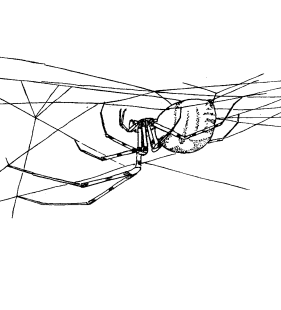Family Nesticidae Simon, 1894
|
In case you find an error or have a specific suggestion, please follow this link: click
|
|||||
| 1 |
Large nesticids (3 – 7 mm) |
||||
| - | Small nesticids (< 3 mm) |
||||
| 2 (1) |
Opisthosoma dorsally without pattern, light greyish; body length 2.0-2.4 mm; posterior eye row nearly strait, PME a little bit closer to PLE than to each other; male pedipalp with small paracymbium, distally dentate, parallel to cymbium; conductor simple, distally pointed; terminal apophysis lacking; epigynal plate with anterior pitted knob, copulatory opening at posterior margin of the epigynal plate; receptacula long and narrow (one cosmopolitan species, in Spain and in greenhouses) |
||||
| - | Opisthosoma unicolorous greyish or with longitudinal rows of ill-defined patches; legs unicolourous in males, but may be annulated in females; body length 2.1 – 2.2 mm; eyes well developed, AME distinctly the smallest; colulus large, long triangular, with many hairs, male palpal tibia as long as wide. In the litter of forests (one species from South-East Asia, introduced to Europe) |
||||
| 3 (1) |
Eyeless; male pedipalpus with very long embolus, thin, with simple apex; paracymbium without modifications, terminal apophysis bulbous, distal part of conductor bipartite, pointed; epigynal plate swollen; vulva ducts very long, coiled; legs very long, leg I 10 x length of prosoma (one species in Montenegro) |
||||
| - | Eyes well developed, reduced or absent; other parameters different |
||||
| 4 (3) |
Note: the delimitations of Nesticus, Carpathonesticus and Aituaria are difficult and some species may currently be placed in the wrong genus. |
| |||
| - | Different |
||||
| 5 (4) |
Male pedipalpus with tegular apophysis reduced to a small hook, distal part of the conductor bipartite, terminal apophysis compact and small, embolus short and thick, with simple apex, embolus round in section, embolic apex simple; paracymbium with simple pointed tip; central modification of the paracymbium barbed or teeth; epigyne plate anteriorly wide, receptaculum subglobular (many species in Eastern Europe) |
||||
| - | Embolus flat in section, embolic apex modified; apex of paracymbium wide blade, more pointed or less sharply transformed to point; central modification of the paracymbium a rounded projection or tooth (2 species in Russia) |
Esyunin SL, Efimik VE (1998) Remarks on the Ural spider fauna, 8. New and unidentified species from steppe landscapes of the south Urals (Arachnida: Aranei). Arthropoda Selecta 7: 145-152.
Lehtinen PT, Saaristo MI (1980) Spiders of the Oriental-Australian region. II. Nesticidae. Ann Zool Fennici 17: 47-66
Further genera
- 1. Daginesticus
- 2. Domitius
- 3. Howaia
- 4. Kryptonesticus
- 5. Sacarum

